

Case Report - Year 2014 - Volume 29 -
Surgical correction of constrictive bands in Vohwinkel syndrome
Abordagem cirúrgica de faixas constritivas em Síndrome de Vohwinkel
ABSTRACT
Vohwinkel syndrome, also known as hereditary mutilating keratoderma, is a rare palmoplantar keratoderma that manifests in childhood and becomes more evident in adolescence and adulthood. This preferential autosomal dominant disease affects more women and Caucasians. Its clinical features are diffuse palmoplantar keratoderma with the appearance of honeycomblike constricting rings in the fingers and toes known as pseudo-ainhum, and starfish-shaped keratotic plaques on the dorsal aspect of the hands and feet that can affect the elbows and knees. The present report describes a case report of a patient with Vohwinkel syndrome and surgical correction of the constrictive bands.
Keywords: Constrictive bands; Self-amputation; Vohwinkel; Digital; Pseudo-ainhum.
RESUMO
A Síndrome de Vohwinkel ou ceratodermia hereditária mutilante é uma ceratodermia palmoplantar rara, que se manifesta na infância e se torna mais evidente nas fases de adolescência e idade adulta. Doença de herança preferencialmente autossômica dominante, acomete mais mulheres e caucasianos. A hiperceratose palmoplantar difusa, com aparência de favo de mel; as faixas constritivas digitais conhecidas como pseudoainhum, e as placas ceratósicas em forma de estrela-do-mar no dorso de mãos e pés, podendo acometer cotovelos e joelhos, são os achados clínicos característicos da Síndrome. O presente trabalho trata de um relato de caso de uma paciente com Síndrome de Vohwinkel e a terapêutica cirúrgica realizada nas faixas constritivas.
Palavras-chave: Faixas constritivas; Autoamputaçao; Vohwinkel; Digitais; Pseudoainhum.
Vohwinkel syndrome, also known as hereditary mutilating keratoderma, was initially described by Vohwinkel in 1929 and is a rare palmoplantar keratoderma that begins in childhood and becomes more evident in adolescence and adulthood1. This preferentially autosomal dominant disease more commonly affects women and Caucasians. By the mid-1980s, only 30 cases had been reported in the literature. We determined through a literature review that there have been only eight cases in Brazil. The clinical findings characteristic of the syndrome are diffuse palmoplantar hyperkeratosis with the appearance of honeycomb-like digital constrictive rings known as pseudo-ainhum, and starfish-like keratotic plaques on the dorsal aspect of the hands and feet that can affect the elbows and knees. Other signs that are sporadically present include alopecia, hearing loss, spastic paraplegia, myopathy, ichthyosiform dermatoses, and nail abnormalities2,3. The treatment of keratoderma is very difficult and usually targets only the symptoms. Topical keratolytic and systemic retinoids have been used to treat hyperkeratosis but have shown inconsistent results. Plastic surgery is an effective alternative to constrictive digital rings which, when left unaddressed, can lead to progressive strangulation and self-amputation3.
OBJECTIVE
To report a case of a patient with Vohwinkel syndrome and the surgical correction performed.
METHOD
Case from June of 2011 in the Department of Plastic Surgery and Reconstructive Microsurgery of the Universidade Federal do Ceará.
CASE REPORT
A 30-year-old woman reported the appearance of callosities on the palms and heels from 2 years of age. The calluses progressed and formed thick, diffuse, and pruritic plaques. Later, there was a gradual emergence of constrictions involving the toes, and two digits self-amputated at 11 years of age. The patient's father and brother had similar medical histories but variable phenotypic manifestations. Upon dermatological examination, hyperkeratoctic and honeycomb-shaped plaque lesions were observed on the palms and soles. The dorsal aspect of the hands and feet exhibited starfish-shaped linear plaques. The patient presented with self-amputation of the right and left fifth toes and constrictive rings between the distal and medial phalanges of the fifth left finger (Figures 1, 2, and 3). No onychodystrophy, alopecia, or other abnormalities were seen on physical examination. The patient's karyotype suggested mutation of the GJB2 gene, which encodes the gap-junction protein connexin 26. Audiometry revealed moderate bilateral sensorineural hearing loss. Radiographs of the hands and feet revealed bone rarefactions and osteoporosis distal to the constrictive rings and an absence of the distal phalanges of the fifth toes. A biopsy of the palmar region revealed hyperkeratosis, hypergranulosis, moderate acanthosis, and a sparse superficial perivascular mononuclear cell infiltrate. Clinical observations and exam findings were compatible with the diagnosis of Vohwinkel syndrome. The patient was prescribed a systemic retinoid (acitretin 0.4 mg/kg/day) with contraceptive measures that improved the hyperkeratosis but did not completely resolve the constrictive rings. She was admitted in June 2011 for surgical correction of the constrictive rings in the distal phalanx of the fifth left digit. After the longitudinal release of the constrictive ring (Figure 4), two full-thickness skin grafts were chosen (Figure 5), removed from the ipsilateral arm, and positioned on the radial and ulnar edges of the left fifth finger (Figure 6). The postoperative outcome was satisfactory (Figures 7 and 8).
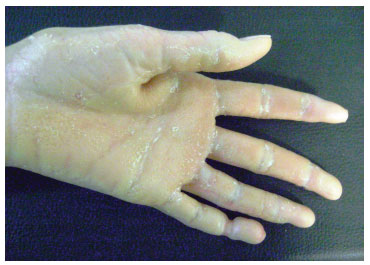
Figure 1. Honeycomb-shaped hyperkeratosis.
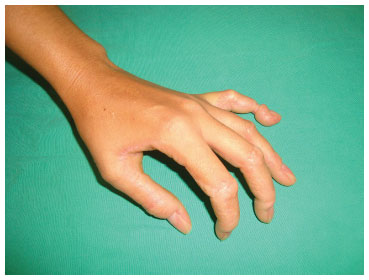
Figure 2. View of the constrictive ring of the fifth digit pre-surgery.

Figure 3. Linear starfish-shaped plaques and self-amputation of the fifth toe.

Figure 4. Longitudinal bilateral release of the constrictive ring.
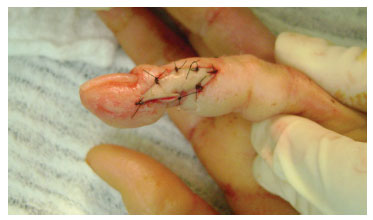
Figure 5. Full-thickness skin grafts.

Figure 6. Grafted radial and ulnar edges of the fifth left finger.
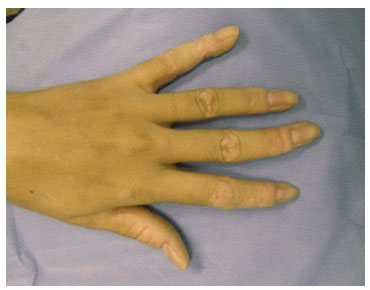
Figure 7. Top view of the hand 30 days after surgical release of the constrictive ring of the fifth digit.
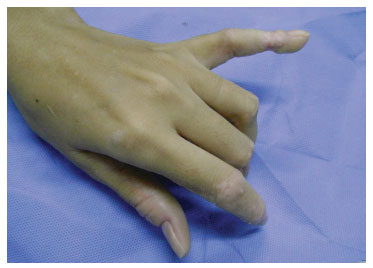
Figure 8. Side view of the hand 30 days after surgical release of the constrictive ring of the fifth digit.
DISCUSSION
The diagnosis of Vohwinkel syndrome was established in a case described according to its clinical characteristics of honeycomb-shaped palmoplantar hyperkeratosis, starfish-shaped keratotic plaques on the dorsal aspect of the hands and feet, and constrictive digital rings involving the fingers and toes associated with sensorineural hearing loss, mutation in the GJB2 gene, and a positive family history1-6. The treatment of Vohwinkel syndrome aims to alleviate the keratoderma and prevent digital self-amputation. The surgical release of the constrictive rings can be used to prevent self-amputation, the most disabling complication of the disease3. In 1995, Pisoh et al. reported Z-plasty as an alternative treatment for constrictive rings3. The literature shows ring recurrence after 1 year of follow-up in cases treated with Z-plasty5,6. In 2010, Bassetto et al. proposed the surgical treatment of a case of a fourth to fifth cross-finger flap on the dorsum of the digit6. In the case described, two full-thickness skin grafts were performed from a donor area on the patient's arm, a procedure that proved quite effective.
CONCLUSION
Despite the recent results, the surgical correction of Vohwinkel syndrome was simple to implement, was reproducible, and prevented self-amputation of the distal phalanx of the fifth digit with satisfactory aesthetic results.
REFERENCES
1. Vohwinkel KH. Keratoma hereditaria mutilans. Arch Derm Syphilol. 1929;158(2):354-64. http://dx.doi.org/10.1007/BF01826619.
2. Lucker GP, Van de Kerkhof PC, Steijlen PM. The hereditary palmoplantar keratoses: an updated review and classification. Br J Dermatol. 1994;131(1):1-14. http://dx.doi.org/10.1111/j.1365-2133.1994.tb08450.x. PMid:8043399
3. Pisoh T, Bhatia A, Oberlin C. Surgical correction of pseudo-ainhum in Vohwinkel syndrome. J Hand Surg [Br]. 1995;20(3):338-41. http://dx.doi.org/10.1016/S0266-7681(05)80090-7. PMid:7561409
4. Maestrini E, Korge BP, Ocaña-Sierra J, Calzolari E, Cambiaghi S, Scudder PM, et al. A missense mutation in connexin26, D66H, causes mutilating keratoderma with sensorineural deafness (Vohwinkel's syndrome) in three unrelated families. Hum Mol Genet. 1999;8(7):1237-43. http://dx.doi.org/10.1093/hmg/8.7.1237. PMid:10369869
5. Atabay K, Yavuzer R, Latifoğlu O, Ozmen S. Keratoderma hereditarium mutilans (Vohwinkel syndrome): an unsolved surgical mystery. Plast Reconstr Surg. 2001;108(5):1276-80. http://dx.doi.org/10.1097/00006534-200110000-00027. PMid:11604631
6. Bassetto F, Tiengo C, Sferrazza R, Belloni-Fortina A, Alaibac M. Vohwinkel syndrome: treatment of pseudo-ainhum. Int J Dermatol. 2010;49(1):79-82. http://dx.doi.org/10.1111/j.1365-4632.2009.04267.x. PMid:20465619
1. Plastic Surgeon, Specialist of the Brazilian Society of Plastic Surgery, Tutor of the Department of Plastic Surgery and Reconstructive Microsurgery, Universidade Federal do Ceará, Fortaleza, CE, Brazil
2. Member of the Brazilian Society of Plastic Surgery, Regent of the Department of Plastic Surgery and Reconstructive Microsurgery, Universidade Federal do Ceará, Fortaleza, CE, Brazil
3. Member of the Society of Plastic Surgery, Preceptor of the Service of Plastic Surgery and Reconstructive Microsurgery, Universidade Federal do Ceará, Fortaleza, CE, Brasil
4. Medical Student, Universidade Federal do Ceará, Member of the Liga de Cirurgia Plástica, Plastic Surgery and Reconstructive Microsurgery Service, Universidade Federal do Ceará, Fortaleza, CE, Brazil
Institution: Work carried out in the Department of Plastic Surgery and Reconstructive Microsurgery of the Universidade Federal do Ceará, Fortaleza, CE, Brazil.
Corresponding author:
Iana Silva Dias
Rua Professor Francisco Goncalves, 1351, Apto. 1602 - Dionísio Torres
Fortaleza, Ceará, Brasil CEP 60135-430
E-mail: ianasilvadias@yahoo.com.br
Article received: June 27, 2011.
Article accepted: July 29, 2011.


 Read in Portuguese
Read in Portuguese
 Read in English
Read in English
 PDF PT
PDF PT
 Print
Print
 Send this article by email
Send this article by email
 How to Cite
How to Cite
 Mendeley
Mendeley
 Pocket
Pocket
 Twitter
Twitter